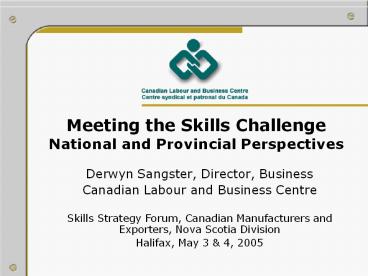Meeting the Skills Challenge National and Provincial Perspectives - PowerPoint PPT Presentation
1 / 16
Title:
Meeting the Skills Challenge National and Provincial Perspectives
Description:
Skills Strategy Forum, Canadian Manufacturers and Exporters, Nova Scotia Division ... While Nova Scotia incurred its lowest net loss through interprovincial migration ... – PowerPoint PPT presentation
Number of Views:29
Avg rating:3.0/5.0
Title: Meeting the Skills Challenge National and Provincial Perspectives
1
Meeting the Skills Challenge National and
Provincial Perspectives
- Derwyn Sangster, Director, Business
- Canadian Labour and Business Centre
- Skills Strategy Forum, Canadian Manufacturers and
Exporters, Nova Scotia Division - Halifax, May 3 4, 2005
2
Underlying DemographicTrends in Canada are
Heightening the Skills Challenge
- Slowing population growth
- Fertility rate is well below replacement level
- Projected decline in working age population after
2016 - A rapidly increasing near-retirement population
- Growing reliance on immigration for labour force
growth
3
Manufacturingan Ageing Workforce
- Between 1998 and 2004, the number of workers
under 55 years of age increased by 7, while
workers age 55 and over increased by 35 - 260,400 manufacturing workers (11 of total) are
age 55 and over - With a median retirement age of 61, employers in
manufacturing may be looking to replace 130,000
workers within five years
Source CLBC, using Labour Force Survey
4
Rising Education and Skill Requirements
- Over the last decade, managerial and professional
occupations requiring university, college or
apprenticeship training account for 74 of
Canadas labour force growth (Statistics Canada) - In the manufacturing sector, the number of
workers with a university degree increased by 49
between 1997 and 2003, while the number of
workers with less than high school declined by
11 - Almost one-half (47) of Canadas manufacturing
workforce has post-secondary education (trades,
college or university)
Source CLBC, Workforce Profile of the
Manufacturing Sector
5
Shortage of Skilled Labour of business and
labour leaders saying it is a serious problem
is on the rise
Source CLBC, Viewpoints Survey
6
High Level of Concern about Skill Shortages among
Managers and Labour Leaders in Nova Scotia
Source CLBC, 2002 Viewpoints Survey
7
Managers and Labour Leaders in Manufacturing
Agree on Top 5 Actions to Address Skills
Requirements
Source CLBC, 2002 Viewpoints Survey
8
Skills in Need of Improvement
Source Canadian Manufacturers Exporters,
2003-2004 Management Issues Survey
9
Where Does Immigration fit in the
Picture?Manufacturing Sector
Source CLBC, 2002 Viewpoints Survey
10
In the Manufacturing Sector 1 in 4 employees
is an immigrant 1 in 10 is a recent immigrant
Source Prepared by the Canadian Labour and
Business Centre, using 2001 Census, custom
tabulations.
11
Reliance on immigrationas a source of labour
varies across the country
Source Prepared by the Canadian Labour and
Business Centre, using 2001 Census, custom
tabulations.
12
How Many Immigrants Come to Nova Scotia Each Year?
Source Prepared by the Canadian Labour and
Business Centre using Citizenship and Immigration
Canada data
13
Retention Rates Recent Immigrants (1996-2001)
by Province
Source Prepared by the Canadian Labour and
Business Centre using Citizenship and Immigration
Canada data and Statistics Canada, Census data
14
Net Migration Between Nova Scotia and other
Provinces and Territories, 1996-2001
15
Summary and Key Observations
- All provinces, including Nova Scotia are facing a
demographic crunch concern about skill shortages
on the rise - Within Manufacturing, skill competencies in
demand include specialized technical skills and
soft skills such as problem solving,
communication and leadership - Upgrading skills of current employees through
training is seen as 1 required action to meet
future skill requirements - Immigration is a increasingly important source of
labour and skills for the manufacturing sector - In Nova Scotia, key challenge is how to attract
and retain immigrants - While Nova Scotia incurred its lowest net loss
through interprovincial migration in 15 years, it
still shows a significant net loss of young
people aged 15 to 29
16
Meeting the Skills ChallengeNational and
Provincial Perspectives
Thank You! Derwyn Sangster Director, Business,
CLBC
- Skills Strategy Forum, Canadian Manufacturers and
Exporters, Nova Scotia Division - Halifax, May 3 4, 2005 February 8, 2005































